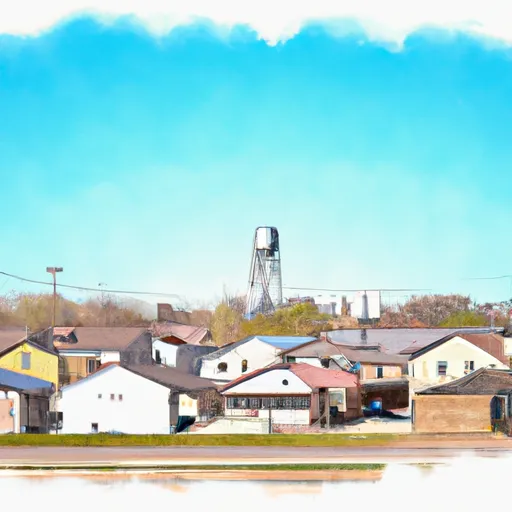-
 Snoflo Premium
Snoflo Premium
Get unlimited access to all our content
With no Ad interruptions! - Start Your Free Trial Login with existing account
Sharon
Eden Index
Climate
9.9
•
Recreation
0.3
•
Community
•
Safeguard
4.0/10

Sharon, Kansas is a small town located in Barber County in the southern part of the state. The climate in Sharon is classified as a humid subtropical climate, characterized by hot, humid summers and cool, dry winters. Summers are typically hot with temperatures often exceeding 90°F (32°C), while winters are mild with temperatures averaging around 40°F (4°C). The area receives an average annual rainfall of 31 inches, which is spread fairly evenly throughout the year.
As for hydrology constituents, Sharon is not located near any major rivers or lakes. However, there are several smaller creeks that flow through the area, providing opportunities for fishing and water activities. These creeks are often stocked with various fish species, including bass, catfish, and crappie.
In terms of outdoor recreation, Sharon is surrounded by beautiful natural landscapes, offering a range of activities such as hunting, hiking, and camping. The nearby Barber State Fishing Lake is a popular spot for anglers and water sports enthusiasts. The area also boasts several wildlife management areas and national forests, providing ample opportunities for outdoor enthusiasts to explore and appreciate the region's diverse flora and fauna.
What is the Eden Index?
The Snoflo Eden Index serves as a comprehensive rating system for regions, evaluating their desirability through a holistic assessment of climate health, outdoor recreation opportunities, and natural disaster risk, acknowledging the profound impact of these factors on livability and well-being.
Climate Health Indicator (CHI): 9.9
Sharon receives approximately
746mm of rain per year,
with humidity levels near 73%
and air temperatures averaging around
15°C.
Sharon has a plant hardyness factor of
6, meaning
plants and agriculture in this region thrive during a short period during spring and early summer. Most
plants will die off during the colder winter months.
By considering the ideal temperature range, reliable water supplies, clean air, and stable seasonal rain or snowpacks, the Climate Health Indicator (CHI) underscores the significance of a healthy climate as the foundation for quality living.
A healthy climate is paramount for ensuring a high quality of life and livability in a region, fostering both physical well-being and environmental harmony. This can be characterized by ideal temperatures, reliable access to water supplies, clean air, and consistent seasonal rain or snowpacks.
Weather Forecast
Streamflow Conditions
Arkansas - Keystone
Area Rivers
Arkansas - Keystone
Snowpack Depths
Arkansas - Keystone
Reservoir Storage Capacity
Arkansas - Keystone
Groundwater Levels
Recreational Opportunity Index (ROI): 0.3
The Recreational Opportunity Index (ROI) recognizes the value of outdoor recreational options, such as parks, hiking trails, camping sites, and fishing spots, while acknowledging that climate plays a pivotal role in ensuring the comfort and consistency of these experiences.
Access to outdoor recreational opportunities, encompassing activities such as parks, hiking, camping, and fishing, is crucial for overall well-being, and the climate plays a pivotal role in enabling and enhancing these experiences, ensuring that individuals can engage in nature-based activities comfortably and consistently.
Camping Areas
| Campground | Campsites | Reservations | Toilets | Showers | Elevation |
|---|---|---|---|---|---|
| Big Bend - Canton Lake | None | 1,674 ft | |||
| Ellinwood City Park | 5 | 1,796 ft | |||
| Sandy Cove - Canton Lake | None | 1,633 ft | |||
| Canadian - Canton Lake | None | 1,643 ft | |||
| Roman Nose State Park | None | 1,455 ft | |||
| Cherokee City RV Park | 16 | 1,180 ft | |||
| Longdale Area - Canton Lake | None | 1,628 ft | |||
| Wolf Pond Park | None | 1,802 ft | |||
| Blaine Park - Canton Lake | None | 1,579 ft | |||
| Cleo Springs RV Park | None | 1,275 ft |
Nearby Fishing
Nearby Ski Areas
Catastrophe Safeguard Index (CSI):
The Catastrophe Safeguard Index (CSI) recognizes that natural disaster risk, encompassing floods, fires, hurricanes, and tornadoes, can drastically affect safety and the overall appeal of an area.
The level of natural disaster risk in a region significantly affects safety and the overall livability, with climate change amplifying these risks by potentially increasing the frequency and intensity of events like floods, fires, hurricanes, and tornadoes, thereby posing substantial challenges to community resilience and well-being.
Community Resilience Indicator (CRI):
The Community Resilience Indicator (CRI) recognizes that education, healthcare, and socioeconomics are crucial to the well-being of a region. The CRI acknowledges the profound impact of these elements on residents' overall quality of life. By evaluating educational resources, healthcare accessibility, and economic inclusivity, the index captures the essential aspects that contribute to a thriving community, fostering resident satisfaction, equity, and social cohesion.

